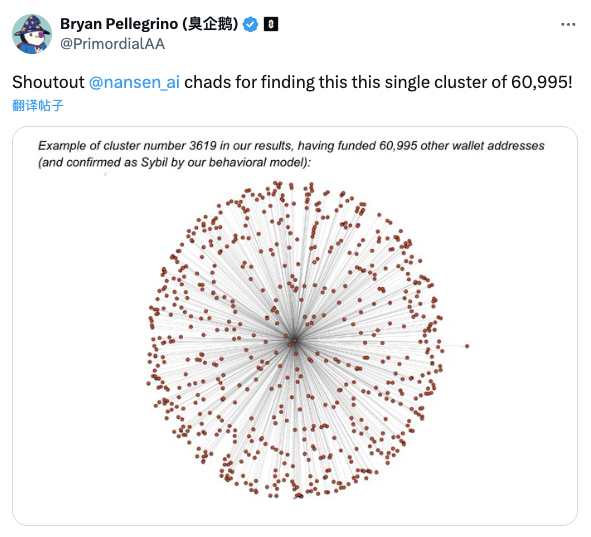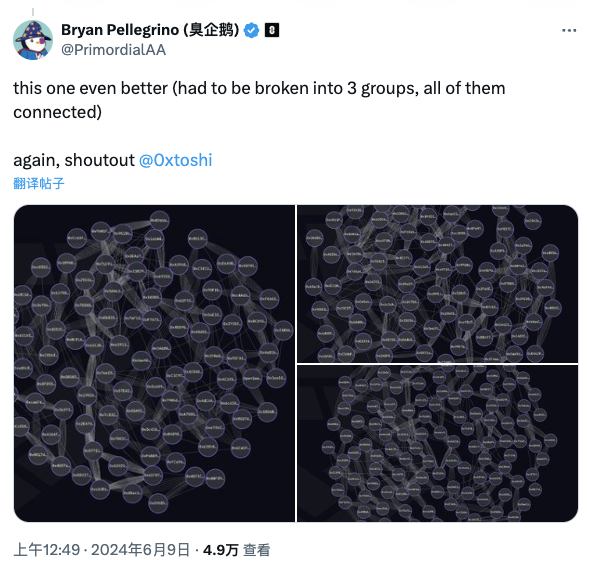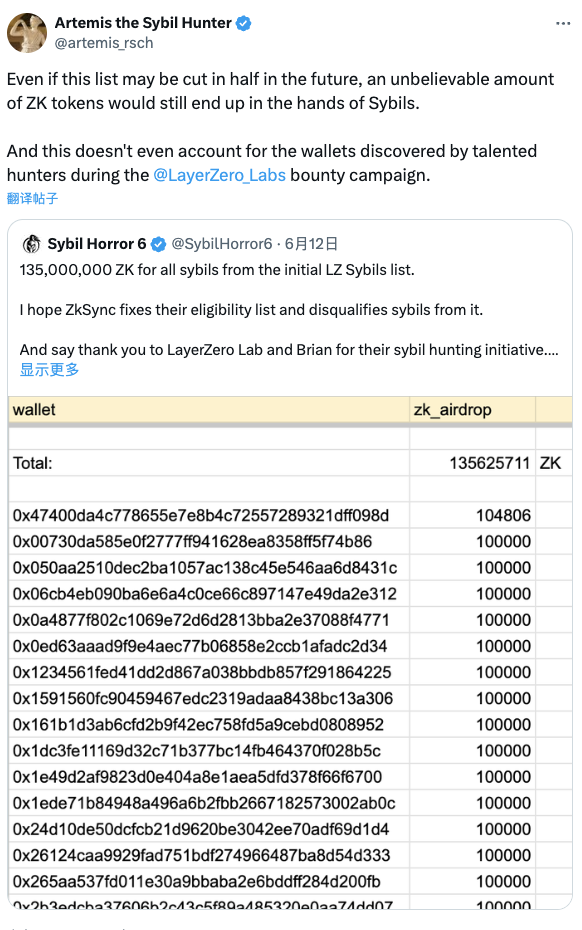Ажиотаж вокруг Airdrop и «охота на ведьм»: новые вызовы и возможности для экосистемы блокчейна
Быстрое развитие технологии блокчейна меняет нашу жизнь и бизнес-модели. В последние годы airdrops привлекли большое внимание как механизм продвижения и стимулирования в экосистеме блокчейна. Однако airdrops часто сопровождаются различными проблемами и рисками, наиболее заметным из которых является атака Сивиллы. В этой статье мы рассмотрим значимость и текущий статус airdrops, проанализируем такие случаи, как LayerZero и ZKSync, поймем, как они справляются с проблемами, и изучим будущее направление развития механизмов airdrop.
Почему проектная партия проводит воздушные сбросы?
Существует несколько причин, по которым блокчейн-проекты выбирают проведение airdrop-раздач, которые определяют ключевое положение airdrop-раздач в экосистеме блокчейна:
-
Повышение видимости и вовлеченности пользователей: Благодаря раздачам токенов проекты могут быстро привлечь большое количество пользователей, расширить размер сообщества и усилить влияние проектов на рынке.
-
Распределите запасы токенов: С помощью airdrop владельцы проектов могут распределять токены среди большего количества пользователей, избегая чрезмерной концентрации токенов в руках нескольких крупных пользователей, тем самым повышая степень децентрализации проекта.
-
Тестовые сети и приложения: С помощью раздач владельцы проектов могут поощрять пользователей к тестированию, тем самым выявляя и устраняя потенциальные проблемы, а также улучшая качество продукта и пользовательский опыт.
-
Поощряйте ранних сторонников: Благодаря раздачам средств владельцы проектов могут вознаградить первых сторонников и повысить лояльность и вовлеченность пользователей.
Проблемы с воздушными выбросами
По мере того, как механизм airdrop становится все более популярным, владельцы проектов также сталкиваются со все большим количеством проблем и потенциальных рисков:
-
Атака Сивиллы: Злоумышленник злоупотребляет наградами за раздачу, создавая большое количество поддельных учетных записей, в результате чего награды, изначально предназначенные для распределения среди реальных пользователей, делятся между большим количеством поддельных учетных записей.
-
Боты: Автоматизированные инструменты и скрипты (боты) могут использоваться для манипулирования голосами и получения бесплатных призов, тем самым подрывая справедливость.
-
Злоупотребление механизмами надзора: Злонамеренные пользователи могут использовать лазейки в системе раздачи криптовалюты для атак или манипулирования, нанося вред здоровому развитию проекта.
LayerZeros Ведьма Sweep
В плане решения проблем с airdrop, LayerZeros Sybil Cleanup стал громким случаем. Они приняли ряд мер для борьбы с атаками Sybil и защиты честности airdrop.
4 мая 2024 г. , LayerZero Labs запустила программу Self-Report Sybil Activity. Если адрес Sybil самостоятельно сообщает соответствующий адрес на указанной странице, он может получить 15% ожидаемого распределения, не отвечая ни на какие вопросы. Крайний срок — 17 мая в 19:59:59.
После окончания периода самоотчета операция по очистке делится на два этапа. На первом этапе , должностное лицо опубликует список всех идентифицированных пользователей Sybil, и те, кто был идентифицирован, но не сообщил об этом самостоятельно, не смогут получить распределения airdrop; на втором этапе , должностное лицо откроет баунти, и пользователи смогут отправлять подробные отчеты о деятельности Sybil. Успешные отчеты приведут к тому, что пользователь Sybil не сможет получить распределение airdrop, а охотник за головами получит 10% от ожидаемой суммы распределения адреса Sybil.
Благодаря этим мерам LayerZero успешно отметил и проверил большое количество потенциальных адресов Сивиллы, повысив честность раздачи.
До 4 июня 2024 г. , Брайан Пеллегрино написал в Твиттере, что отчет о ведьмах рассматривается, и пользователи могут подавать возражения. Хотя включение в список отчетов увеличит риск того, что соответствующий адрес будет считаться ведьмой, это не означает, что адрес обязательно будет признан ведьмой. Окончательный список ведьм еще не опубликован, и текущий отчет может быть ложноположительным, что будет проверено в конце. Окончательная версия списка адресов ведьм будет объявлена до конца июня.
Затем на 8 июня 2024 г. Брайан Пеллегрино снова написал в Твиттере, что Нансен подтвердил 60 995 адресов как кластеры адресов Сивиллы:
И несколько скриншотов других адресов студийных ведьм:
Долгожданный план раздачи ZKSync
После LayerZero, ZKSync, решение уровня 2, основанное на технологии масштабирования доказательства с нулевым разглашением (ZK-Rollup), также недавно привлекло большое внимание, особенно его недавно запущенный план airdrop. Ассоциация ZKSync проведет единовременную airdrop 3,6 млрд токенов ZK для первых пользователей и последователей на следующей неделе, и есть 695 232 подходящих кошелька. Время снимка — 24 марта 2024 года. Участники сообщества могут проверить право на airdrop на https://claim.zknation.io/ и воспользуйтесь раздачей со следующей недели до 3 января 2025 года.
Этот эйрдроп представляет 17.5% от общего объема поставок токенов ZK. Пользователи смогут получить свои токены, начиная с 24 июня 2024 года, а период получения продлится до 3 января 2025 года.
Пользователи, имеющие право на бесплатную раздачу ZKSync
Квалификации и критерии для распределения ZKSync через airdrop очень строгие, чтобы гарантировать, что вознаграждение получат только настоящие пользователи и участники:
-
Пользователи (89%): Активные пользователи ZKSync, которые совершают транзакции на ZKSync и достигают порога активности.
-
Участники (11%): Отдельные лица, разработчики, исследователи, сообщества и компании, которые вносят вклад в экосистему и протокол ZKSync посредством разработки, пропаганды или обучения.
Право на участие определяется на основе снимка активности ZKSync Era и ZKSync Lite по состоянию на 24 марта 2024 года в 00:00 UTC.
Как распространяется ZKSync airdrop
ZKSync распределяет воздушные капли на основе торговой активности пользователей и их активов на ZKSync Era и ZKSync Lite:
-
Право на участие: Каждый адрес, подающий заявку на эйрдроп, должен иметь как минимум один кредит, указывающий на его активность на ZKSync.
-
Расчет распределения: Распределение airdrop рассчитывается на основе активов пользователей в ZKSync Era (включая активы в кошельках и DeFi) и времени удержания этих активов. Верхний предел airdrop для одного адреса составляет 100 000 ZK.
-
Награды за множитель: Пользователи также могут получать множители распределения, удерживая собственные NFT ZKSync, участвуя в проектах DeFi и других мероприятиях, отражающих их вклад в экосистему ZKSync.
Обнаружение ведьм
В этой раздаче особое внимание уделяется обнаружению Сивиллы, чтобы гарантировать, что награды достанутся реальным пользователям. ZKSync использует анализ данных в цепочке и распознавание поведенческих шаблонов для устранения адресов Сивиллы, тем самым обеспечивая справедливость и эффективность распределения.
Интересно, что он не начал масштабную охоту на ведьм, но его широко критиковали за это. Среди 690 000 адресов, которые получили воздушные капли, не только были неясны детали воздушных капель, но и было несколько адресов ведьм, которые были проверены. По словам охотника на ведьм Артемиса, некоторые инсайдерские трейдеры получили более 2 миллионов токенов ZK, внося те же средства Ethereum в тот же день, и почти все счета были отмечены в списке ведьм LayerZeros.
Будущее воздушных десантов
Давнее молчаливое понимание правил airdrop между шерстяной партией и партией проекта, похоже, вызвало недопонимание между ними. Многие пользователи считают, что airdrop — это трудовой доход, которого они заслуживают. На медвежьем рынке пользователи усердно и активно работают, вносят плату за обработку, чтобы обеспечить доход, и помогают проекту создать иллюзию процветания в цепочке, поэтому они должны быть вознаграждены. Однако эти пользователи более целеустремленны, и партией проекта может быть не полностью вовлечена.
Первоначально проект не планировал конфронтацию с сообществом, но после того, как тысячи студий присоединились к армии зарабатывания денег, им пришлось быть более осторожными в вопросах раздачи контента.
Планы airdrop от LayerZero и ZKSync демонстрируют инновационные меры управления, принимаемые блокчейн-проектами при столкновении с такими проблемами, как атаки Сивиллы. Эти случаи дают ценный опыт для будущих проектов airdrop.
В текущей экосистеме криптовалют различные планы airdrop по-прежнему сталкиваются с огромными проблемами и возможностями. Мы надеемся, что больше блокчейн-проектов смогут извлечь уроки из этого успешного опыта и разработать более справедливый, прозрачный и безопасный механизм airdrop, чтобы способствовать здоровому развитию всей экосистемы. Как проектные команды, так и обычные пользователи должны сохранять осторожное и инновационное отношение в этой волне новых технологических изменений и совместно использовать бесконечные возможности в этом море звезд.
Статья взята из Интернета: Аирдроп Безумие и ведьмовство: новые вызовы и возможности для экосистемы блокчейна
По теме: Pantera: Почему TON — наш главный актив?
Оригинальная статья: Дэн Морхед, основатель Pantera Capital, и Райан Барни, партнер Составитель: Odaily Planet Daily Azuma Примечание редактора: Эта статья из 100-й статьи колонки комментариев рынка Pantera Capitals Blockchain Letter, в которой в основном выдержки из анализа TON. Заявление о позиции номер один исходит от основателя Pantera Capital Дэна Морхеда. Дэн упомянул, что недавно обедал с основателем Telegram Павлом Дуровым, и Pantera недавно сделала крупнейшую инвестицию в блокчейн-проект Telegram TON за всю историю фонда. Помимо этого, большую часть статьи написал партнер Pantera Capital Райан Барни. Почему Pantera выбрала TON? (Дэн Морхед) На протяжении всей своей карьеры я искал отличные инвестиции. Я увлечен биткоином и…










